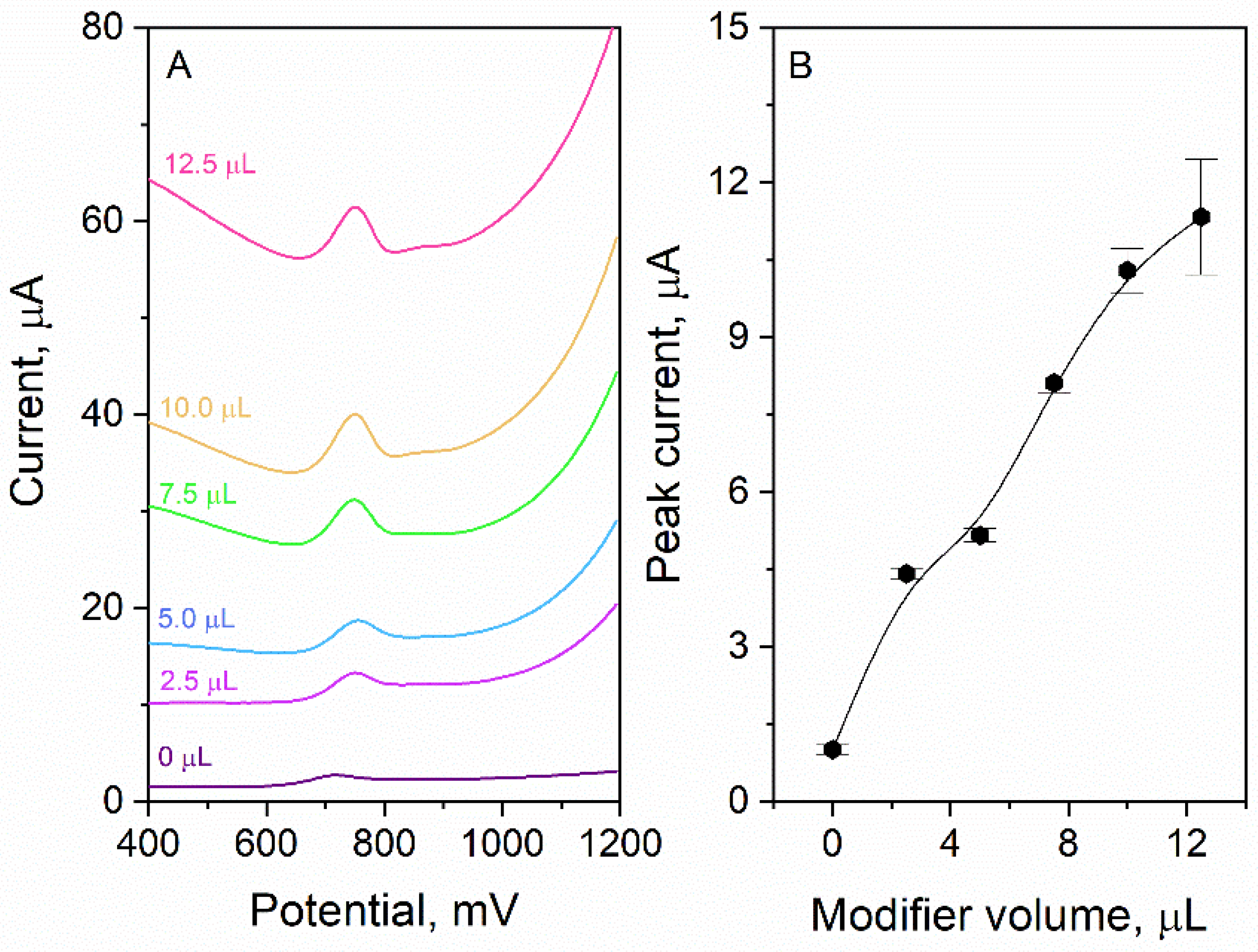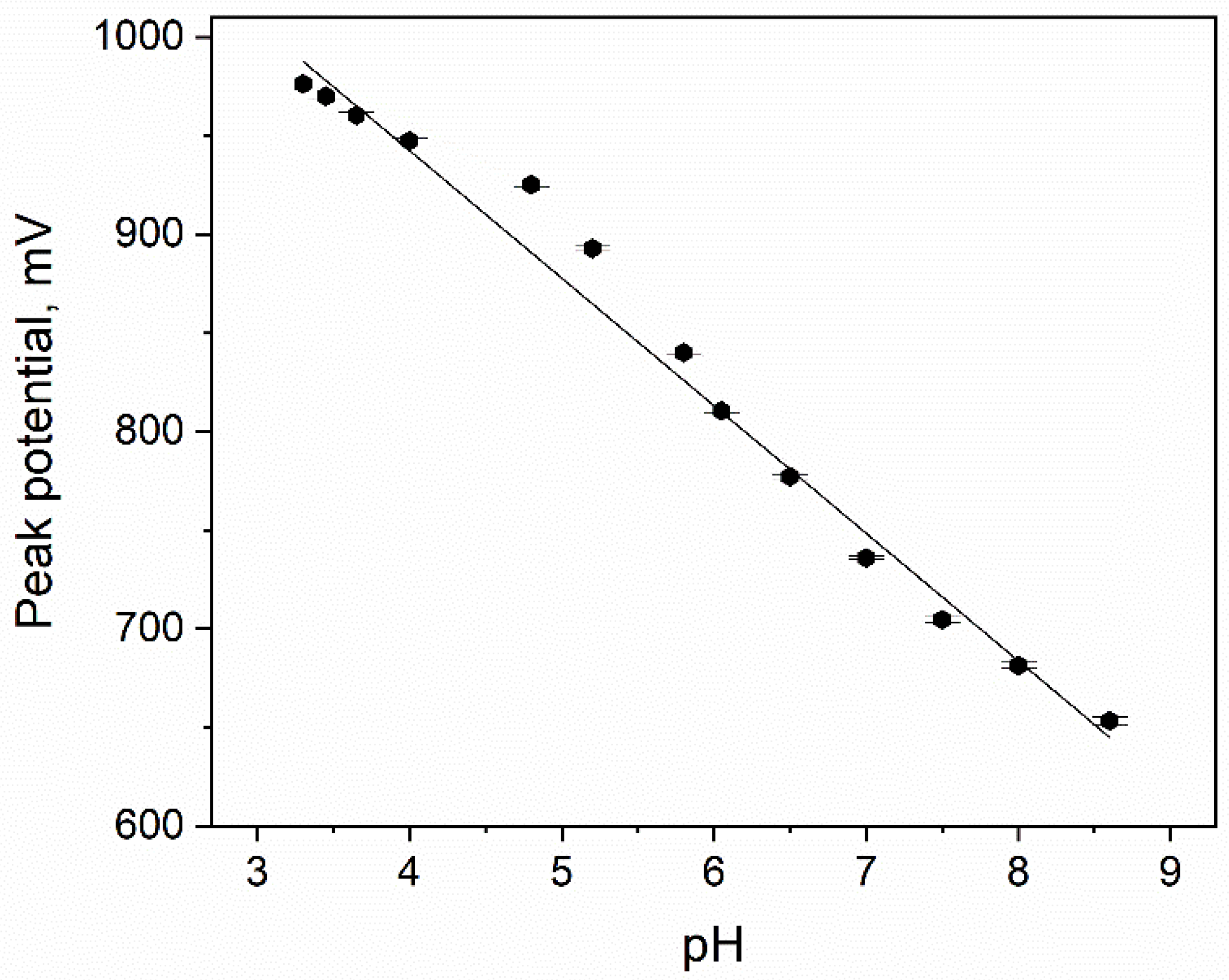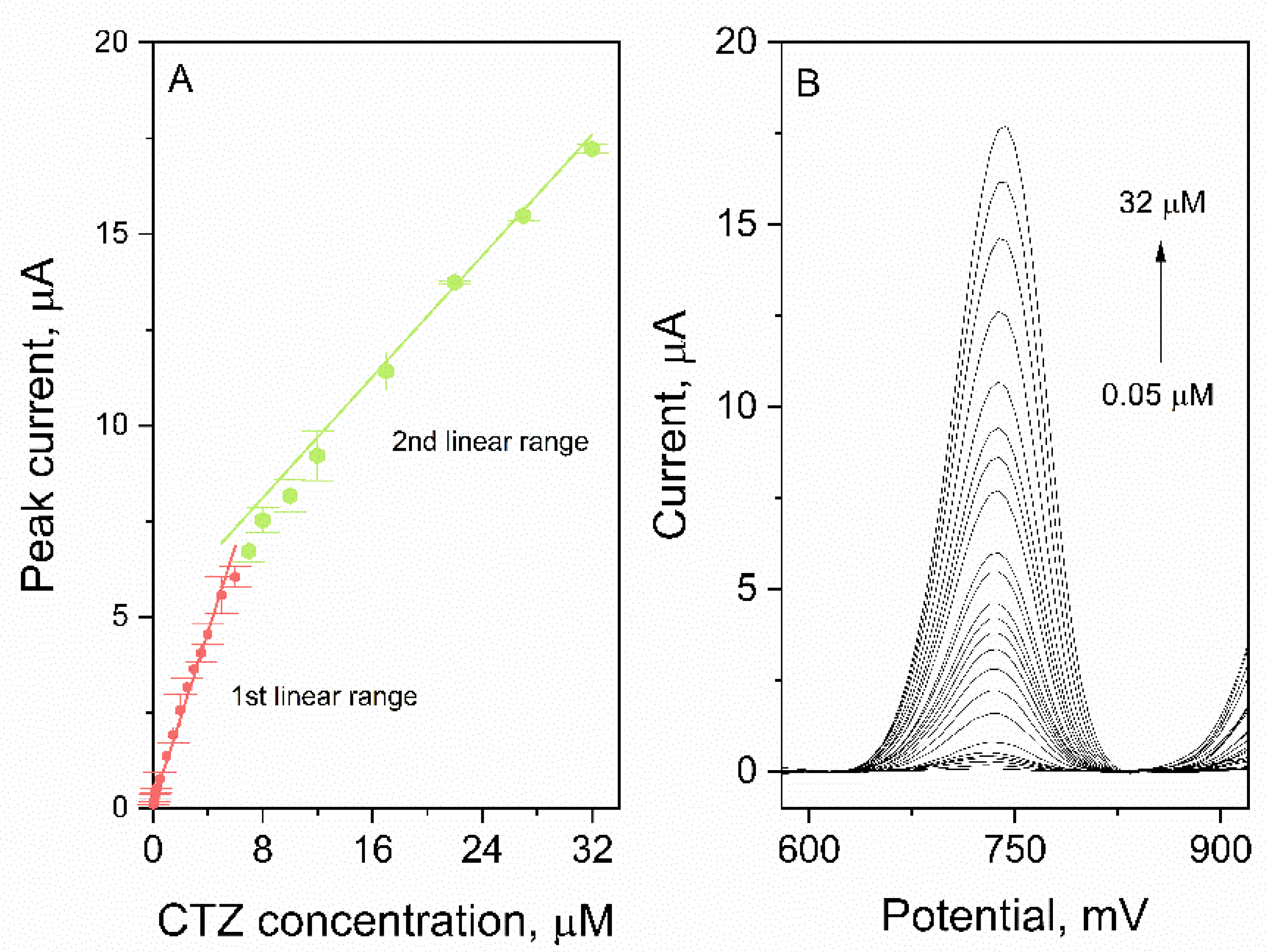New Electrochemical Sensor Based on Hierarchical Carbon Nanofibers with NiCo Nanoparticles and Its Application for Cetirizine Hydrochloride Determination
Abstract
:1. Introduction
2. Experimental
2.1. Apparatus
2.1.1. Characterization of Nanocomposite
2.1.2. Analytical Measurements
2.2. Chemicals and Glassware
2.3. Sample Preparation
2.3.1. Tablets
2.3.2. Lyophilizate Urine
2.3.3. Plasma
2.4. Synthesis of Nanocomposite
2.5. Working-Electrode Preparation
- Homogenization of modifier suspension—ultrasonic bath for 45 min (every 15 min, the water in the bath was changed to fresh water to prevent overheating of the suspension);
- Application of the modifier suspension (7.5 µL) on the surface of the prepared GCE;
- Evaporation of the solvent from the modifier—approximately 3 h.
2.6. Measurement Procedure
- Cleaning of the electrode surface: E = −1200 mV; t = 10 s;
- Accumulation step: Eacc = 300 mV; tacc = 10 s;
- Rest period: t = 3 s;
- Voltammograms registration in the potential range 300–1200 mV.
3. Results
3.1. Characterization of Nanocomposite
3.2. Sensors Characterization
3.2.1. Volume of Surface Modifier
3.2.2. The Reproducibility and Repeatability of the Sensor
3.3. Cetirizine Behavior on the Surface of eCNF/CNT/NiCo-GCE
3.4. Supporting-Electrolyte Optimization
3.4.1. Type of the Supporting Electrolyte
3.4.2. Concentration of Phosphate Buffer
3.5. DPV Parameters Optimization
3.6. Accumulation Potential and Time Optimization
3.7. Interferences Study
3.8. Analytical Performance
4. Conclusions
Supplementary Materials
Author Contributions
Funding
Informed Consent Statement
Data Availability Statement
Conflicts of Interest
References
- Aldred, E.M.; Buck, C.; Vall, K. Respiratory Diseases. In Pharmacology: A Handbook for Complementary Healthcare Professionals; Churchill Livingstone: London, UK, 2009; pp. 267–272. ISBN 9780443068980. [Google Scholar]
- Isaacs, M.J.; Tharp, M.D. Antihistamines. In Comprehensive Dermatologic Drug Therapy; Elsevier: Amsterdam, The Netherlands, 2021; pp. 349–359. ISBN 9780323612111. [Google Scholar]
- Portnoy, J.M.; Dinakar, C. Review of Cetirizine Hydrochloride for the Treatment of Allergic Disorders. Expert Opin. Pharmacother. 2004, 5, 125–135. [Google Scholar] [CrossRef] [PubMed]
- Aronson, J.K. Cetirizine. In Meyler’s Side Effects of Drugs—The International Encyclopedia of Adverse Drug Reactions and Interactions; Elsevier: Amsterdam, The Netherlands, 2016; pp. 220–223. [Google Scholar]
- Schlatt, L.; Costa, A.C.C.; Barz, V.; Ciarimboli, G.; Karst, U. Fast Simultaneous Quantification of Gabapentin and Cetirizine in Cell Lysates by Means of HPLC-MS/MS. J. Pharm. Biomed. Anal. 2020, 184, 113172. [Google Scholar] [CrossRef] [PubMed]
- Dewani, A.P.; Dabhade, S.M.; Bakal, R.L.; Gadewar, C.K.; Chandewar, A.V.; Patra, S. Development and Validation of a Novel RP-HPLC Method for Simultaneous Determination of Paracetamol, Phenylephrine Hydrochloride, Caffeine, Cetirizine and Nimesulide in Tablet Formulation. Arab. J. Chem. 2015, 8, 591–598. [Google Scholar] [CrossRef] [Green Version]
- Karakuş, S.; Küçükgüzel, I.; Küçükgüzel, Ş.G. Development and Validation of a Rapid RP-HPLC Method for the Determination of Cetirizine or Fexofenadine with Pseudoephedrine in Binary Pharmaceutical Dosage Forms. J. Pharm. Biomed. Anal. 2008, 46, 295–302. [Google Scholar] [CrossRef] [PubMed]
- Kang, S.W.; Jang, H.J.; Moore, V.S.; Park, J.Y.; Kim, K.A.; Youm, J.R.; Han, S.B. Enantioselective Determination of Cetirizine in Human Plasma by Normal-Phase Liquid Chromatography-Atmospheric Pressure Chemical Ionization-Tandem Mass Spectrometry. J. Chromatogr. B Anal. Technol. Biomed. Life Sci. 2010, 878, 3351–3357. [Google Scholar] [CrossRef]
- Tan, Z.R.; Ouyang, D.S.; Zhou, G.; Wang, L.S.; Li, Z.; Wang, D.; Zhou, H.H. Sensitive Bioassay for the Simultaneous Determination of Pseudoephedrine and Cetirizine in Human Plasma by Liquid-Chromatography-Ion Trap Spectrometry. J. Pharm. Biomed. Anal. 2006, 42, 207–212. [Google Scholar] [CrossRef]
- Drozd, J.; Hopkała, H.; Misztal, G.; Paw, B. Applications of Derivative Uv Spectrophotometry for the Determinations of Cetirizine Dihydrochloride in Pharmaceutical Preparations. Acta Pol. Pharm.-Drug Res. 2002, 59, 3–7. [Google Scholar]
- El Walily, A.F.M.; Korany, M.A.; El Gindy, A.; Bedair, M.F. Spectrophotometric and High Performance Liquid Chromatographic Determination of Cetirizine Dihydrochloride in Pharmaceutical Tablets. J. Pharm. Biomed. Anal. 1998, 17, 435–442. [Google Scholar] [CrossRef]
- Azhagvuel, S.; Sekar, R. Method Development and Validation for the Simultaneous Determination of Cetirizine Dihydrochloride, Paracetamol, and Phenylpropanolamine Hydrochloride in Tablets by Capillary Zone Electrophoresis. J. Pharm. Biomed. Anal. 2007, 43, 873–878. [Google Scholar] [CrossRef]
- Uysal, Ü.; Tunçel, M. Validated Capillary Electrophoresis Study for the Determination of Cetirizine in Pharmaceutical Forms. J. Liq. Chromatogr. Relat. Technol. 2006, 29, 1781–1792. [Google Scholar] [CrossRef]
- Kalambate, P.K.; Srivastava, A.K. Simultaneous Voltammetric Determination of Paracetamol, Cetirizine and Phenylephrine Using a Multiwalled Carbon Nanotube-Platinum Nanoparticles Nanocomposite Modified Carbon Paste Electrode. Sens. Actuators B Chem. 2016, 233, 237–248. [Google Scholar] [CrossRef]
- Patil, R.H.; Hegde, R.N.; Nandibewoor, S.T. Electro-Oxidation and Determination of Antihistamine Drug, Cetirizine Dihydrochloride at Glassy Carbon Electrode Modified with Multi-Walled Carbon Nanotubes. Colloids Surf. B Biointerfaces 2011, 83, 133–138. [Google Scholar] [CrossRef] [PubMed]
- Pushpanjali, P.A.; Manjunatha, J.G.; Hareesha, N.; Souza, E.S.D.; Charithra, M.M.; Prinith, N.S. Voltammetric Analysis of Antihistamine Drug Cetirizine and Paracetamol at Poly(L-Leucine) Layered Carbon Nanotube Paste Electrode. Surf. Interfaces 2021, 24, 101154. [Google Scholar] [CrossRef]
- Gholivand, M.B.; Shamsipur, M.; Ehzari, H. Cetirizine Dihydrochloride Sensor Based on Nano Composite Chitosan, MWCNTs and Ionic Liquid. Microchem. J. 2019, 146, 692–700. [Google Scholar] [CrossRef]
- Vernekar, P.R.; Shetti, N.P.; Shanbhag, M.M.; Malode, S.J.; Malladi, R.S.; Reddy, K.R. Novel Layered Structured Bentonite Clay-Based Electrodes for Electrochemical Sensor Applications. Microchem. J. 2020, 159, 105441. [Google Scholar] [CrossRef]
- Culková, E.; Lukáčová-Chomisteková, Z.; Bellová, R.; Melicherčíková, D.; Durdiak, J.; Timko, J.; Rievaj, M.; Tomčík, P. Boron-Doped Diamond Film Electrode as Voltammetric Sensor for Cetirizine. Int. J. Electrochem. Sci. 2018, 13, 6358–6372. [Google Scholar] [CrossRef]
- Karakaya, S.; Dilgin, D.G. Low-Cost Determination of Cetirizine by Square Wave Voltammetry in a Disposable Electrode. Mon. Chem. 2019, 150, 1003–1010. [Google Scholar] [CrossRef]
- Güngör, S.D. Electrooxidation of Cetirizine Dihydrochloride with a Glassy Carbon Electrode. Pharmazie 2004, 59, 929–933. [Google Scholar]
- Pushpanjali, P.A.; Manjunatha, J.G.; Sreeharsha, N.; Asdaq, S.M.B.; Anwer, M.K. A Highly Responsive Voltammetric Methodology for the Sensing of Antihistamine Drug Cetirizine on the Surface of Cetrimonium Bromide Immobilized Multi-Walled Carbon Nanotube Electrode. J. Mater. Sci. Mater. Electron. 2021, 32, 22668–22679. [Google Scholar] [CrossRef]
- Al-Harbi, E.A. Fabrication and Application of Bismuth-Film Modified Glassy Carbon Electrode as sensor for Highly Sensitive Determination of Cetirizine Dihydrochloride in Pharmaceutical Products and Water Samples. Int. J. Electrochem. Sci. 2021, 16, 211036. [Google Scholar] [CrossRef]
- Shetti, N.P.; Malode, S.J.; Nayak, D.S.; Reddy, K.R. Novel Heterostructured Ru-Doped TiO2/CNTs Hybrids with Enhanced Electrochemical Sensing Performance for Cetirizine. Mater. Res. Express 2019, 6, 115085. [Google Scholar] [CrossRef]
- Sipa, K.; Brycht, M.; Leniart, A.; Skrzypek, S. The Application of Carbon Nanomaterials as Electrode Surface Modifiers for the Voltammetric Sensing of Nitroxinil—A Comparative Study. J. Electroanal. Chem. 2019, 848, 113294. [Google Scholar] [CrossRef]
- Rudnicki, K.; Brycht, M.; Leniart, A.; Domagała, S.; Kaczmarek, K.; Kalcher, K.; Skrzypek, S. A Sensitive Sensor Based on Single-walled Carbon Nanotubes: Its Preparation, Characterization and Application in the Electrochemical Determination of Drug Clorsulon in Milk Samples. Electroanalysis 2020, 32, 375–383. [Google Scholar] [CrossRef]
- Kummari, S.; Sunil Kumar, V.; Yugender Goud, K.; Vengatajalabathy Gobi, K. Nano-Au Particle Decorated Poly-(3-amino-5-hydroxypyrazole) Coated Carbon Paste Electrode for In-Vitro Detection of Valacyclovir. J. Electroanal. Chem. 2021, 904, 115859. [Google Scholar] [CrossRef]
- Fernández, I.; González-Mora, J.L.; Lorenzo-Luis, P.; Villalonga, R.; Salazar-Carballo, P.A. Nickel Oxide Nanoparticles-Modified Glassy Carbon Electrodes for Non-enzymatic Determination of Total Sugars in Commercial Beverages. Microchem. J. 2020, 159, 105538. [Google Scholar] [CrossRef]
- Górska, A.; Paczosa-Bator, B.; Piech, R. Highly Sensitive Levodopa Determination by Means of Adsorptive Stripping Voltammetry on Ruthenium Dioxide-Carbon Black-Nafion Modified Glassy Carbon Electrode. Sensors 2021, 21, 60. [Google Scholar] [CrossRef]
- Veera Manohara Reddy, Y.; Sravani, B.; Łuczak, T.; Mallikarjuna, K.; Madhavi, G. An Ultra-Sensitive Rifampicin Electrochemical Sensor Based on Titanium Nanoparticles (TiO2) Anchored Reduced Graphene Oxide Modified Glassy Carbon Electrode. Colloids Surf. A Physicochem. Eng. Asp. 2021, 608, 125533. [Google Scholar] [CrossRef]
- Smajdor, J.; Paczosa–Bator, B.; Piech, R. Voltammetric Electrode Based on Nafion and Poly(2,3–dihydrothieno–1,4–dioxin)–poly(styrenesulfonate) Film for Fast and High Sensitive Determination of Metamizole. J. Electrochem. Soc. 2016, 163, B146–B152. [Google Scholar] [CrossRef]
- Manasa, G.; Mascarenhas, R.J.; Basavaraja, B.M. Sensitively-Selective Determination of Propyl Paraben Preservative Based on Synergistic Effects of Polyaniline-Zinc-Oxide Nano-Composite Incorporated into Graphite Paste Electrode. Colloids Surf. B Biointerfaces 2019, 184, 110529. [Google Scholar] [CrossRef]
- Zambrzycki, M.; Fraczek-Szczypta, A. Study on the Synthesis and Properties of Hierarchically Structured Electrospun/Vapour-Grown Carbon Nanofibres Nanocomposites. J. Ind. Eng. Chem. 2020, 86, 100–112. [Google Scholar] [CrossRef]







| Type of WE | LOD, nM | Reference |
|---|---|---|
| CPE-MWCNTs-Pt | 58.6 | [14] |
| PLMCNTPE | 170 | [16] |
| Bent/CPE | 59.1 | [18] |
| CTABMCNTPE | 270 | [22] |
| RuTiO2-MWCNTs | 3.1 | [24] |
| MWCNT-GCE | 70.7 | [15] |
| chitosan/IL/MWCNTs/GCE | 8 | [17] |
| BiF-GCE | 1.5 | [23] |
| GCE | 4500 | [21] |
| GPE | 160 | [20] |
| BDDE | 16 | [19] |
| eCNF/CNT/NiCo-GCE | 14 | This work |
| Sample | CTZ Added, mg | CTZ Found ± s, mg (Recovery, %) |
|---|---|---|
| Allertec WZF a | 0 | 10.9 ± 0.7 |
| 10 | 25.0 ± 0.9 (108) | |
| 20 | 34 ± 3 (100) | |
| Cirrus Duo b | 0 | 5.5 ± 0.2 |
| 5 | 12.9 ± 0.1 (109) | |
| 10 | 17.3 ± 0.6 (110) | |
| Sample | CTZ added ± s, µM | CTZ found ± s, µM (recovery, %) |
| Urine diluted 40× | 0 | ND |
| 1 | 1.1 ± 0.1 (108) | |
| 2 | 2.3 ± 0.3 (110) | |
| Urine diluted 10× | 0 | ND |
| 3 | 3.1 ± 0.2 (103) | |
| 6 | 6.9 ± 0.5 (110) | |
| Plasma diluted 125× | 0 | ND |
| 1 | 1.2 ± 0.1 (115) | |
| 2 | 2.3 ± 0.3 (113) | |
| Plasma diluted 35× | 0 | ND |
| 3 | 3.3 ± 0.2 (109) | |
| 6 | 5.8 ± 0.5 (97) |
Publisher’s Note: MDPI stays neutral with regard to jurisdictional claims in published maps and institutional affiliations. |
© 2022 by the authors. Licensee MDPI, Basel, Switzerland. This article is an open access article distributed under the terms and conditions of the Creative Commons Attribution (CC BY) license (https://creativecommons.org/licenses/by/4.0/).
Share and Cite
Górska, A.; Zambrzycki, M.; Paczosa-Bator, B.; Piech, R. New Electrochemical Sensor Based on Hierarchical Carbon Nanofibers with NiCo Nanoparticles and Its Application for Cetirizine Hydrochloride Determination. Materials 2022, 15, 3648. https://doi.org/10.3390/ma15103648
Górska A, Zambrzycki M, Paczosa-Bator B, Piech R. New Electrochemical Sensor Based on Hierarchical Carbon Nanofibers with NiCo Nanoparticles and Its Application for Cetirizine Hydrochloride Determination. Materials. 2022; 15(10):3648. https://doi.org/10.3390/ma15103648
Chicago/Turabian StyleGórska, Anna, Marcel Zambrzycki, Beata Paczosa-Bator, and Robert Piech. 2022. "New Electrochemical Sensor Based on Hierarchical Carbon Nanofibers with NiCo Nanoparticles and Its Application for Cetirizine Hydrochloride Determination" Materials 15, no. 10: 3648. https://doi.org/10.3390/ma15103648
APA StyleGórska, A., Zambrzycki, M., Paczosa-Bator, B., & Piech, R. (2022). New Electrochemical Sensor Based on Hierarchical Carbon Nanofibers with NiCo Nanoparticles and Its Application for Cetirizine Hydrochloride Determination. Materials, 15(10), 3648. https://doi.org/10.3390/ma15103648








